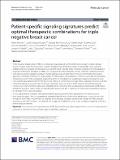Patient-specific signaling signatures predict optimal therapeutic combinations for triple negative breast cancer
Author(s)
Alkhatib, Heba; Conage-Pough, Jason; Roy Chowdhury, Sangita; Shian, Denen; Zaid, Deema; Rubinstein, Ariel M.; Sonnenblick, Amir; Peretz-Yablonsky, Tamar; Granit, Avital; Carmon, Einat; Kohale, Ishwar N.; Boughey, Judy C.; Goetz, Matthew P.; ... Show more Show less
Download12943_2023_Article_1921.pdf (3.545Mb)
Publisher with Creative Commons License
Publisher with Creative Commons License
Creative Commons Attribution
Terms of use
Metadata
Show full item recordAbstract
Triple negative breast cancer (TNBC) is a heterogeneous group of tumors which lack estrogen receptor, progesterone receptor, and HER2 expression. Targeted therapies have limited success in treating TNBC, thus a strategy enabling effective targeted combinations is an unmet need. To tackle these challenges and discover individualized targeted combination therapies for TNBC, we integrated phosphoproteomic analysis of altered signaling networks with patient-specific signaling signature (PaSSS) analysis using an information-theoretic, thermodynamic-based approach. Using this method on a large number of TNBC patient-derived tumors (PDX), we were able to thoroughly characterize each PDX by computing a patient-specific set of unbalanced signaling processes and assigning a personalized therapy based on them. We discovered that each tumor has an average of two separate processes, and that, consistent with prior research, EGFR is a major core target in at least one of them in half of the tumors analyzed. However, anti-EGFR monotherapies were predicted to be ineffective, thus we developed personalized combination treatments based on PaSSS. These were predicted to induce anti-EGFR responses or to be used to develop an alternative therapy if EGFR was not present.
In-vivo experimental validation of the predicted therapy showed that PaSSS predictions were more accurate than other therapies. Thus, we suggest that a detailed identification of molecular imbalances is necessary to tailor therapy for each TNBC. In summary, we propose a new strategy to design personalized therapy for TNBC using pY proteomics and PaSSS analysis. This method can be applied to different cancer types to improve response to the biomarker-based treatment.
Date issued
2024-01-16Department
Massachusetts Institute of Technology. Department of Biological Engineering; Koch Institute for Integrative Cancer Research at MITJournal
Molecular Cancer
Publisher
BioMed Central
Citation
Molecular Cancer. 2024 Jan 16;23(1):17
Version: Final published version